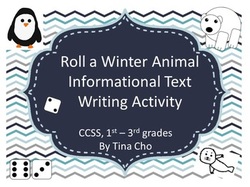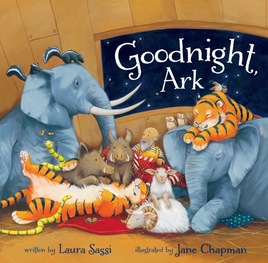 It's the first week of January, and you've probably already got a list of goals or things to do. As I promised, I'm going to do a series on making a product for Teachers Pay Teachers, or you could make it an educational product that fits one of your stories to put on your own web site. During Christmas break, I made one new product, which you see on the left, "Roll a Winter Animal Informational Text," and I'm also finished with another product which I'll probably upload tomorrow if all goes well. Here are some steps you can start with as you think about the type of educational product you'd like to create. 1. Go to the Teachers Pay Teachers web site and research just like you would a publisher. When I'm at a publisher's site, I look at the type of books they sell, new releases, what's popular, etc... You can do the same thing at TpT. First,along the left side menu of TpT, select the grade level you're interested in, and you can even select the subject matter. Then just peruse the products. You can tell which ones are "hot," or best sellers because they have a lot of downloads and reviews. (I just started my store, so my products are not "hot!") On the bottom of the TpT site, they also list the most popular selling products and highest-selling stores. Take a look at these. What are they doing that's so successful? Take notes. Make a list of popular topics and topics that you DON'T see. 2. Start brainstorming ideas for a product that you think teachers would love. Maybe it's a teacher's guide for your book, complete with ready-to-go printables (the fancy name for worksheets) or a nonfiction article with questions aligned with Common Core Standards, or a game that teaches a standard in one of the main subjects. Ask your child's teacher what seems to be needed! 3. If you're gung-ho about opening an online store on TpT, by all means go ahead. They have a free membership for buyers and sellers. If you don't have a free buyers membership, you can sign up for one. That means if there's a product you want to buy or a free product you want to download, you're allowed. If you want to sign up as a free seller, you could do that right now. You don't have to set up your store right away. If you want to think about it, do so. If you're not an educator, you could always email TpT and explain your situation and see if they'd let you be a seller. My mentor did that; she's not a teacher, but her husband is. And they let her have a store. You can see Nancy I. Sander's store here. Okay, I think that's enough for this first post. If you know of others who want to learn, please have them subscribe to the blog! See you next time for the next lesson *probably* on finding clip art for your product. (subject to change) If you have questions or comments, please leave them below!
10 Comments
 I'd like to welcome my writing critique friend, Laura Sassi! This is the last stop on her blog tour for her debut picture book, Goodnight, Ark, which was published by Zonderkidz. This is an adorable, rocking read aloud! If you are a teacher, you're eligible to win a free 30 minute Skype session for your classroom with Laura. Enter at the end of this post. Take it away, Laura! I can’t imagine a more pleasant place to finish up the GOODNIGHT, ARK blog tour than here with Tina. Tina and I are writing partners, but we are also both teachers at heart. I taught elementary school for eight years before writing and she taught elementary for eleven years. Today, I’d like put on that teacher hat and think about creating extension activities for the picture books we write. But how do you get started? Here are four brainstorming strategies I recommend. Notice what your readers notice. Even before ARK officially released, I read my advance copy to my children and young relatives. I showed it to friends. I was even lucky enough to get to share a folded galley with my mom. As we read, I listened carefully to what each reader noticed. My mom, for example, was fascinated by Jane’s use of stripes, dots, and other patterns throughout her illustrations. Other readers noticed the pattern in rhyme and meter. Yet others commented on the patterns of repeated words and sounds. Pulling those pattern-thoughts together, I created “Going on a Pattern Hunt”, an extension activity that challenges kids to find picture, text, and sound patterns in GOODNIGHT, ARK and then create their own. That extension activity is now available on my blog. Build upon the Common Core. A close look at your book’s listing on Amazon or at your local library will show you which common core standards your book meets. The three listed for GOODNIGHT, ARK are: 1.CCSS.ELA-Literacy.RL.1.2 Retell stories, including key details, and demonstrate understanding of their central message or lesson. 2.CCSS.ELA-Literacy.RL.1.3 Describe characters, settings, and major events in a story, using key details. 3.CCSS.ELA-Literacy.RL.1.4 Identify words and phrases in stories or poems that suggest feelings or appeal to the senses. I am now in the process of using these as jumping off points for creating fun activities that include the learning elements above. Stay tuned… they’ll be up on my blog soon. Get input from a teacher. Whether you are a teacher or not, I highly recommend showing your story to several teachers. I did and I was amazed at the lesson suggestions. One teacher in particular got really excited about all the spelling lesson possibilities that can be drawn from GOODNIGHT, ARK. And she’s right! The text is full of short vowels, long vowels, adverbs, blends galore, digraphs, rhyming words and more! I would never have thought of this, but I’m now creating fun spelling extensions for primary graders. I’ve also got lessons in mind that will focus on cause and effect, making predictions, and counting by twos. Thank you, teachers! Think multi-sensory. Kids learn and process things differently and so don’t forget to take a multi-sensory approach. My son, for example, is very visual and verbal, so visual/verbal activities work well for him. My daughter is more of a kinesthetic, artistic learner. So, as I brainstorm, I strive to meet all kinds of learning styles with activities that include movement, art, and interactive activities. I also love crafts and will definitely include extension posts that require glue and scissors. So there you have it. Writers, I hope these strategies will spark your creative teaching juices as you think about extension activities for your own stories. Teachers, I hope you will check out my blog in the coming weeks as I continue to post extension activities for GOODNIGHT, ARK. Thanks, Tina, for having me. It’s been a lovely last spot for a tour. *If you're an educator and would like to win a free Skype visit for your classroom, please leave your name and and the grade you teach in the comments below. A winner will be drawn on Saturday, 9/27. Please check back on Sunday for the results!  Bio: Laura’s poems, stories, articles and crafts have appeared in many publications including Highlights for Children, Cricket, Ladybug, Spider, Focus on the Family’s Clubhouse and Clubhouse Jr., FamilyFun, and Pack-O-Fun. GOODNIGHT, ARK, published by Zonderkidz, a HarperCollins Company, and illustrated by Jane Chapman is her first picture book. She is represented by Lara Perkins of the Andrea Brown Literary Agency. Laura writes from her century-old home in New Jersey where she lives with her awesome husband, two adorable kids, and a black cockapoo named Sophie. You can also find her on her blog, Facebook, and Twitter.  Here's a list of all the stops on Laura's blog tour if you want to read other posts. 8/26 The Stylin’ Librarian 8/28 Picture Book Den 9/3 Pragmatic Mom 9/5 Time out with Becky Kopitzke 9/8 Rosanne L. Kurstedt’s KALEIDOSCOPE 9/10 Southern Belleview Daily 9/12 Susanna Leonard Hill 9/17 GROG 9/18 Tara Lazar’s Writing While Raising Kids 9/22 Le&ndra’s Blog 9/24 Tina’s Tidbits |
Tina M. Cho, children's authorI'm a children's author and freelance writer for the educational market. Welcome! Archives
March 2024
Categories
All
|




 RSS Feed
RSS Feed
